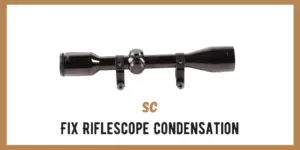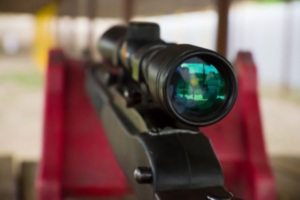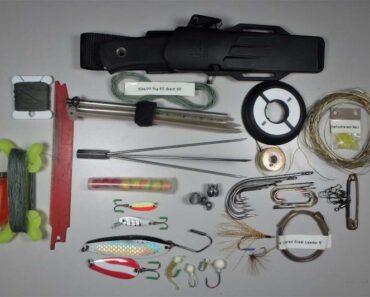Nothing can spoil a hunt faster than finding your scope fogged up just as that trophy buck steps into view. Many hunters wonder why their riflescopes fog up. Are there ways to remedy this situation and prevent it from happening?

Condensation on a riflescope is one problem. Condensation inside a riflescope is an entirely different matter. Moisture accumulating on the outside of your scope lenses comes from temperature differences. Finding the inside of your scope foggy signifies the scope is damaged. More than likely, the seals are compromised and the nitrogen inside the scope has leaked away.
There are several ways to deal with exterior condensation on your riflescope. A bit of preparation before you hunt is usually sufficient to prevent condensation on the lenses and rifle. However, if there is moisture inside your scope, there is no permanent fix short of sending the riflescope back to the manufacturer.
Why Does Moisture Collect on My Rifle and Scope?
It isn’t unusual for moisture to collect on anything during exposure to moist air outdoors. Condensation typically happens if you take your rifle and scope from a cool air-conditioned space into a warm and moist outside area.
Storing your rifle in your house where it stays cool and dry is a great idea. Taking the cool rifle out into a warm day when the humidity is high can result in the moisture in the air collecting on the rifle, particularly the cold lenses. A ride in an air-conditioned vehicle can have the same effect.
Condensation is usually not a problem when the rifle and scope are warm, taking them into a cold environment. Since most hunting happens in the fall and winter, most hunters never experience condensation on the exterior of their scope.
How Can I Prevent Condensation on the Lenses of My Riflescope?
There are several solutions to the problem of condensation on riflescope lenses. Some of these solutions may void the warranty of your scope, so be careful.
Acclimatize your Rifle and Scope
The number one reason moisture accumulates on the outside of your scope and rifle is the temperature difference. When the scope and rifle are much warmer than the cold outside air, moisture will collect on the rifle and scope as it cools. This condensation happens naturally.
To keep your rifle and scope from fogging up or collecting condensation, you can take several steps.
- Allow your rifle and scope a few minutes to adjust to the outside temperature. Taking a warm rifle and scope from your home or car into a cold environment will almost always result in moisture accumulations.
- If you must drive to your hunting location, carry your cased rifle and scope in the coldest part of your vehicle. The idea is to allow the rifle and scope to adjust to the temperature slowly during the ride.
- When you arrive at your hunting site, open the case containing your rifle and scope and let them further adjust to the temperature. Open the lens covers if you have them on your scope.
- Avoid breathing on your cold scope lenses. Warm breathes may be a problem with scopes having sort eye reliefs. A cold scope lens will condense the moisture in your breath on the lens of your scope almost immediately.
Treating your Scope Lenses
Many shooters swear by different products for preventing condensation on the lenses of their riflescopes. Some of these products are questionable and may void the warranty on your scope. If there is any question about your scope’s warranty, check with the manufacturer before putting anything on your scope’s lenses. A few of the recommendations from other shooter’s include:
- Cat Crap Lens Cleaner – EK USA manufactures Cat Crap Lens Cleaner. Many shooters, as well as others who use optical equipment, recommend this product. EK USA advertises that their Cat Crap Lens Cleaner is safe to use on all lenses and will help prevent condensation and fogging issues.
Last update on 2021-09-06 at 04:33 / Affiliate links / Images from Amazon Product Advertising API
- Care Touch Lens Cleaner Kit – Some shooters use the Care Touch Lens Cleaner Kit on their riflescope lenses. Care Touch claims that their product is safe for all lenses with anti-fogging, anti-glare, and protective coatings when used according to the included directions.
Last update on 2021-09-06 at 04:34 / Affiliate links / Images from Amazon Product Advertising API
- Dishwashing Liquid Soap – Some shooters report that they use a very dilute solution of liquid dishwashing soap on the lenses of their scopes. We suspect this is a carryover from some scuba divers. Many divers rinse the inside of their masks with a dishwashing soap solution before diving. The protective coatings used on riflescopes are much different than scuba masks. Check with the manufacturer of your scope before using anything on your scope lenses.
Our Recommendations for Condensation on your Scope
In general, we don’t recommend putting anything on the lenses of your scope other than a lens brush and a microfiber lens clothe that you only use for your scope. A bit of preplanning and preparation will almost always prevent condensation on your rifle and scope.
If possible, store your rifle and scope to come to the same temperature as the outside air slowly. A quick transition from a cool house or car to a warm moist environment is a recipe for problems.
If you experience condensation on your riflescope lenses, give the scope time to adjust to the surrounding temperature. Often, the condensation will evaporate. If you must wipe your scope lenses, the only thing you should use is a microfiber lens clothe dedicated to your riflescope.
If you breathe on your scope and it fogs, resist the temptation to use your thumb or finger to swipe the lens. Wiping at the moisture with a finger will only make matters worse. You will smear the moisture over the lens, making it even harder to see through. You also risk damaging the coatings on the lens.
Condensation: A Natural Problem
Condensation on the outside of your rifle and scope are natural occurrences that you should anticipate. A little care and preplanning can almost always prevent our scope from fogging up, but it will happen in some instances.
What if the Lens on my Riflescope has Moisture Inside?
If you notice moisture collecting on the inside of your riflescope lens, you have much more serious problems than simple condensation. Moisture inside a riflescope is a symptom of damaged seals on the tube. When the seals are damaged, the nitrogen inside the scope tube leaks away and allows outside moisture-laden air to enter the scope.
Typically, damaged seals on scopes are not a user-serviceable item. To properly repair the seals and refill the scope with nitrogen requires the scope to go back to the manufacturer for a rebuild. In many cases, if a reputable manufacturer makes the scope, this process is covered by the scope warranty. However, many cheaper scopes don’t have this kind of warranty coverage.
Can I Remove the Moisture from Inside My Riflescope?
Warming the scope is the most suggested method of removing interior moisture. We don’t recommend this method on more expensive scopes.
Gently warm your riflescope. In some instances, warming the scope gently will remove the visible moisture from the interior of the scope. Shooters suggest various methods of warming a scope to reduce or remove fogging on the inside of your scope.
- Placing the scope in a warm oven can dry out the interior of the scope temporarily.
- Sitting the scope in direct sunshine where it can warm naturally is another suggested remedy
- Heating the scope with a blow-drier has been suggested to reduce or eliminate fogging inside a scope.
Remember that any of these methods are temporary at best and may void any warranty on your scope. Moisture inside your riflescope is a sure sign that the scope is damaged. Two permanent fixes are your options in this case.
- Send the riflescope back to the manufacturer for repair. Most reputable riflescope manufacturers will repair your riflescope. The manufacturer will usually replace the seals, refill the scope with nitrogen and return it to you in pristine condition. Check with the manufacturer of your scope about the terms and conditions of the warranty.
- The other option is to purchase a new scope of better quality and with a good warranty. Cheap scopes typically have a lifetime of 3 to 5 years, depending on the kind of use. Many more expensive scopes come with a lifetime no questions asked warranties.
How Can I Protect My Riflescope Lenses?
A little common sense goes a long way when talking about keeping riflescope protected. Our recommendations for protecting your riflescope from damage include:
- Avoid moving your scope between temperature extremes if possible. Don’t take a rifle and scope from a very warm environment into a very cold environment quickly. Quick and extreme temperature changes can stress the seals. The same holds for going from a very cold environment to an extremely hot environment.
- Protect the lenses of your riflescope with good lens caps. We prefer flip-up caps. Some shooters find a bra-style lens cap more to their liking. Whichever you choose, use them diligently to protect the lenses and their coatings.
- It would be best if you used the proper tools to clean your lenses. A good lens brush and a dedicated lens microfiber clothe are the only things that should ever touch your riflescope lenses.
- Don’t spray anything on your riflescope or its lenses, especially household window cleaners. These products contain ingredients that can damage or strip away the lens coatings and may harden the seals causing them to crack.
Condensation – In or Out: Two Distinctly Different Problems
Condensation on the outside of your rifle and scope is a natural occurrence. Many times, a little preparation and preplanning will help mitigate or eliminate these problems. If your scope is in good condition, outside condensation shouldn’t affect the way the scope performs.
Moisture inside your scope is a much more serious issue. In most cases, a fogged lens on the inside signals damage to the scope. The only permanent fix for this condition is a trip back to the manufacturer for repair or replacement.
We hope you found this information helpful. If you have comments to suggestions, please use the section below to reply. We all appreciate you sharing your knowledge and expertise. Be Safe and shoot straight.





![5 Keys To Survival Bartering [PODCAST] 5 Keys To Survival Bartering [PODCAST]](https://survivalcove.com/wp-content/uploads/2021/09/The-survival-show-podcast-banner-370x297.jpg)





















